What Makes Latino Content… Latino?
June 4, 2021 – Most of the debate related to people of color in the media comes down to two subjects — how are we portrayed and do we see ourselves enough on-screen. The topic of on-screen representation seems to get more politicized with every award show, much like everything else in our increasingly polarized society today. Just this year alone, the Grammys and the Golden Globes found themselves in the eye of the representation storm.
But is our screen time the key metric we should be focused on? From a marketing point of view shouldn’t we be asking ourselves another question? Let’s take another approach and rephrase the question.
What makes a tortilla chip… a tortilla chip?
Bear with me a moment. I recently bought a bag of chips and immediately made the connection with the issue at hand. The brand I bought intrigued me. They were dairy-free Nacho Siete Grain Free Tortilla Chips. I don’t know about you, but when I think of either tortilla chips or nacho chips, I think chips made from fried corn tortillas – right? Well, these particular chips were made of many natural ingredients to be sure, but no corn. I cannot be certain, but they may not have even been fried either. The main ingredients consist of casava and coconut flours and various powdered spices for flavor.
Don’t get me wrong – they were very tasty and virtually guilt free. But the parallels to the question of the day are clear to me. If we can call anything a tortilla chip, then we can call any content that we – as Hispanics – like…well, Latino content.
Broadening the Definition of Hispanic Content
As marketers and advertisers, we should widen our definition of Latino content to any program or any outlet that our target audience watches, regardless of language. Take “The Crown” for example. It runs among the over 30,000 hours of Spanish-language content available on Netflix. If our audience can watch it in Spanish, it might as well be Latino content. You have to admit that it bears a strong resemblance to our standard “novela” fare. The broader our definition of Latino content, the more relevance we as agencies have in the broader marketing industry of America.
We should agree as an industry that Hispanic content is anything that Latinos want to watch, listen to or read. Anything they want to consume and spend money on – regardless of language, who stars in it, what channel it is on, who wrote it, who produced it…you get the idea. We Latinos come in many shades of brown from white to black and brown to yellow. And we speak across a broad spectrum of Spanish – from none to Spanglish to “real academia” with a wide variety of regional and country-of-origin nuance.
Latino Inclusion Matters
I have written before that our “raza” here in the United States is a mash-up of 22 national origins, three races, infinite mixes between them, and millions born on U.S. soil, all blending with the general citizenry of this country for dozens of generations going back hundreds of years. The point is that I am not sure we can define Latino content any more than we can define Latino.
By no means should we give up the fight for more inclusion as actors, directors, producers, editors, show runners, and every supporting trade in the film, television and video content industries. There is something to be said for the prismatic points of view we Hispanics bring to any endeavor. Not to mention the empowering impact on self-esteem it would have on the 25% of Gen Z’ers who identify as Hispanic. But when it comes to who we produce content for, we may be looking for a distinction without a difference.
For more discussion about the Hispanic Market, check out the infographic in our MARKET IQ section on our website, www.d2hispanic.com
Marcelino Miyares, Jr. – Managing Partner – D2H Partners, LLC – 2021
About d2H Partners – Los Angeles based full-service Hispanic Advertising Agency focused on D2C and B2B Spanish language campaigns targeting immigrant, first-generation and “billenial” Hispanics. d2H specializes in creating, adapting, and delivering targeted messages to Latinos to profitably enculturate your message, media and metrics.
